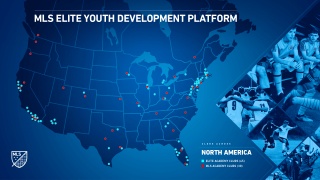
In April, the United States Soccer Development Academy, the main cog in developing America’s National Teams, ceased operations in the wake of the COVID-19 pandemic.
It didn’t take long for that hole to be filled.
“When the DA dropped it was about 45 minutes later that the MLS made a decision. This wasn’t a premeditated thing. They weren’t planning this prior but they made a collective decision to fill that space,” says Noah Gins, CEO and Executive Director of Albion SC.
While most of the country is contracting during the coronavirus outbreak Major League Soccer saw an opportunity to expand, investing upwards of $10 million to absorb 65 youth clubs from across the country to create the MLS Elite Youth Development Platform.
Albion SC is one of four local clubs joining the new venture, along with Chula Vista FC, Nomads (La Jolla) and City SC (Carlsbad). That means San Diego County has more clubs in this development system than 43 entire states. This is a bold and surprising move by MLS.
“I was surprised,” says Gins. “It was a great surprise, it was an exciting one, but one that we were all probably a little hesitant as to what it meant.”
Spending that kind of money during a pandemic will, rightly, raise some eyebrows. The obvious question is, what does Major League Soccer get out of this? For one, a truckload of name recognition and marketing opportunity.
Local
“The value in the league, I think, goes beyond money for them,” says David Armstrong, Technical Director of Nomads Soccer Academy. “To bring in the fan base, it’s a long-term investment for the exposure to the league. They truly want this to be one of the best leagues in the world.”
Along with that, eventually, comes the financial payoff.
“They, ultimately, want to sell that $40 million or $80 million player to the rest of the world,” says Armstrong. “They want homegrown players coming through, going to their programs, just as every other country does.”
Transfer fees can be massive. The record is Neymar going from Barcelona to Paris Saint-Germain for $265 million. The highest amount paid to an MLS team for a transfer is $5.92 million, which Toronto FC got from Rangers in Scotland for Maurice Edu. The hope with this new development circuit is to create a North American soccer system that rivals those of massive European clubs.
“The focus is on building a legacy in this country with respect to the game and changing the game as we know it,” says Gins.
That could include changing the World Cup fortunes of the United States Men’s National Team. Organizers joining the MLS development model hope more homegrown players will translate to a stronger American soccer program.
“Yes, I do think so,” says J. Hector Diaz, Director of Coaching for Chula Vista FC. “I think in the past the organizers of the league have had different objectives. When the first division of a professional league takes over I think the objective is clear and that’s to produce players at the elite level.”
For now the program only applies to boys clubs but MLS has expressed interest in expanding to a girls club development program, as well. San Diego will also be well-represented if that happens.
“This is what we’ve been veering for,” says Diaz. “We really want to get kids out into the professional game. I’m just excited. That’s an exciting opportunity for those players and I’m glad they’re going to have it now.”
U.S. National Team star Christian Pulisic is one of the leading scorers for legendary European club Chelsea. If this new partnership works as well as MLS hopes, Pulisic will just be the tip of the spear.



